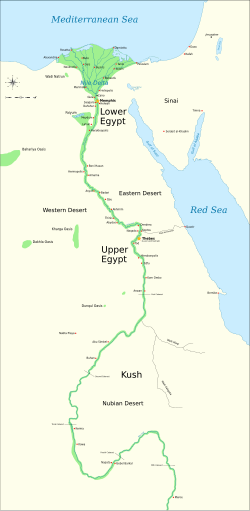
Back Eerste Oorgangstydperk van Egipte Afrikaans الفترة المصرية الانتقالية الأولى Arabic عصر الاضمحلال الاولانى ARZ Birinci aralıq dövr (Misir) Azerbaijani بیرینجی آرا دؤنم AZB Першы пераходны перыяд (Егіпет) Byelorussian Първи преходен период на Древен Египет Bulgarian মিশরের প্রথম অন্তর্বর্তী যুগ Bengali/Bangla Kentañ marevezh etre Henegipt Breton Primer Període Intermedi d'Egipte Catalan
First Intermediate Period of Egypt | |||||||||
|---|---|---|---|---|---|---|---|---|---|
| c. 2181 BC–c. 2055 BC | |||||||||
 | |||||||||
| Capital |
| ||||||||
| Common languages | Ancient Egyptian | ||||||||
| Religion | Ancient Egyptian religion | ||||||||
| Government | Monarchy | ||||||||
| Pharaoh | |||||||||
• c. 2181 BC | Menkare (first) | ||||||||
• c. 2069 BC – c. 2061 BC | Intef III (last; Theban) Merykare (last; Herakleopolitan) | ||||||||
| History | |||||||||
• Began | c. 2181 BC | ||||||||
• Ended | c. 2055 BC | ||||||||
| |||||||||
| Today part of | Egypt | ||||||||
| History of Egypt |
|---|
 |
|
|
| Periods and dynasties of ancient Egypt |
|---|
|
All years are BC |
The First Intermediate Period, described as a 'dark period' in ancient Egyptian history,[1] spanned approximately 125 years, c. 2181–2055 BC, after the end of the Old Kingdom.[2] It comprises the Seventh (although this is mostly considered spurious by Egyptologists), Eighth, Ninth, Tenth, and part of the Eleventh Dynasties. The concept of a "First Intermediate Period" was coined in 1926 by Egyptologists Georg Steindorff and Henri Frankfort.[3]
Very little monumental evidence survives from this period, especially from the beginning of the era. The First Intermediate Period was a dynamic time in which rule of Egypt was roughly equally divided between two competing power bases. One of the bases was at Heracleopolis in Lower Egypt, a city just south of the Faiyum region, and the other was at Thebes, in Upper Egypt.[4] It is believed that during that time, temples were pillaged and violated, artwork was vandalized, and the statues of kings were broken or destroyed as a result of the postulated political chaos.[5] The two kingdoms would eventually come into conflict, which would lead to the conquest of the north by the Theban kings and to the reunification of Egypt under a single ruler, Mentuhotep II, during the second part of the Eleventh Dynasty. This event marked the beginning of the Middle Kingdom of Egypt.
- ^ Redford, Donald B. (2001). The Oxford encyclopedia of ancient Egypt. Vol. 1. Cairo: The American University in Cairo Press. p. 526.
- ^ Kathryn A. Bard, An Introduction to the Archaeology of Ancient Egypt (Malden: Blackwell Publishing, 2008), 41.
- ^ Schneider, Thomas (27 August 2008). "Periodizing Egyptian History: Manetho, Convention, and Beyond". In Klaus-Peter Adam (ed.). Historiographie in der Antike. Walter de Gruyter. pp. 181–197. ISBN 978-3-11-020672-2.
- ^ Gardiner, Alan (1961) Egypt of the Pharaohs (Oxford University Press), 107–109.
- ^ Breasted, James Henry (1923). A History of the Ancient Egyptians. Charles Scribner's Sons, 133.